Canis Major is a constellation in the southern sky. Its name means “the greater dog” in Latin. Canis Major represents the bigger dog following Orion, the hunter in Greek mythology. The Great Dog is often depicted pursuing a hare, represented by the constellation Lepus. The smaller dog is represented by the nearby constellation Canis Minor.
Both dog constellations are among the 48 Greek constellations, first catalogued by Claudius Ptolemy of Alexandria in his Almagest in the 2nd century CE.
Canis Major is home to Sirius, the brightest star in the sky, and to the red hypergiant VY Canis Majoris, one of the largest stars known. The constellation also hosts several notable deep sky objects. These include the bright open clusters Messier 41, Caroline’s Cluster (NGC 2360), and the Tau Canis Majoris Cluster (NGC 2362), the colliding spiral galaxies NGC 2207 and IC 2163, the Canis Major Dwarf Galaxy, and the emission nebulae NGC 2359 (Thor’s Helmet Nebula) and Sh2-308 (the Dolphin Head Nebula).
Facts, location and map
Canis Major is the 43rd biggest constellation in the sky, occupying an area of 380 square degrees. It is located in the second quadrant of the southern celestial hemisphere (SQ1). The entire constellation can be seen from locations between the latitudes +60° and -90°. The neighboring constellations are Columba, Lepus, Monoceros, and Puppis.
The constellation name Canis Major is pronounced /ˈkeɪnɪs ˈmeɪdʒər/. In English, the constellation is known as the Great Dog. The genitive form of Canis Major, used in star names, is Canis Majoris (pronunciation: /ˈkeɪnɪs məˈdʒɒrɪs/). The three-letter abbreviation, adopted by the International Astronomical Union (IAU) in 1922, is CMa.
Canis Major belongs to the Orion family of constellations, along with Canis Minor, Lepus, Monoceros, and Orion. It is one of three dog constellations in the sky. The other two are Canis Minor (the Little Dog) and Canes Venatici (the Hunting Dogs).
The Canis Major constellation contains one Messier object, the star cluster Messier 41 (NGC 2287). There are no meteor showers associated with the constellation.
Sirius (Alpha Canis Majoris), the brightest star in Canis Major, is also the brightest star in the night sky. Popularly known as the Dog Star, Sirius shines at magnitude -1.47 from a distance of only 8.60 light-years.
The Great Dog hosts at least 10 stars with known planets: the orange giants Nu2 Canis Majoris, HD 47536 and HD 47366, the yellow dwarfs WASP-64 (Atakoraka), HATS-4, HD 45364, HD 45184 and HD 47186, the F-type star WASP-101, and the yellow or orange main sequence star or subgiant HD 43197 (Amadioha).
Canis Major contains 10 formally named stars. The star names approved by the International Astronomical Union (IAU) are Adhara (Epsilon Canis Majoris A), Aludra (Eta Canis Majoris), Amadioha (HD 43197), Atakoraka (WASP-64), Furud (Zeta Canis Majoris Aa), Mirzam (Beta Canis Majoris), Muliphein (Gamma Canis Majoris), Sirius (Alpha Canis Majoris A), Unurgunite (Sigma Canis Majoris), and Wezen (Delta Canis Majoris Aa).
The best time of the year to observe the stars and deep sky objects in Canis Major is during the month of February, when the constellation appears higher above the horizon around 9 pm.
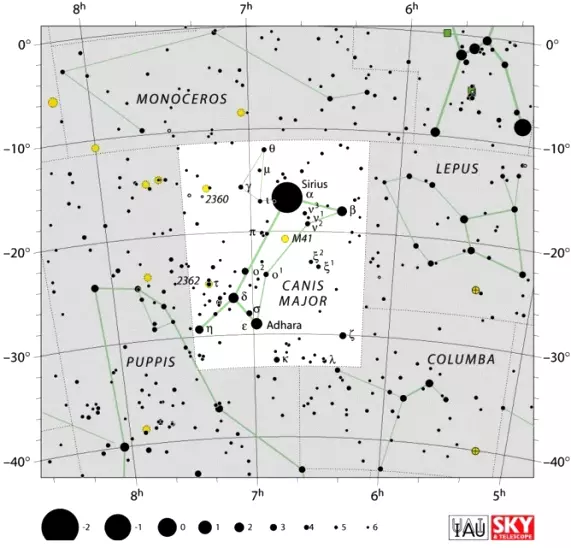
Canis Major constellation map by IAU and Sky&Telescope magazine
Myth
Canis Major is commonly taken to represent the “greater dog” following the hunter Orion in Greek mythology. The constellation is depicted as a dog standing on its hind legs, pursuing a hare, represented by the constellation Lepus.
Canis Major was described by Manilius as “the dog with the blazing face” because the dog appears to hold Sirius, the brightest star in the sky, in its jaws.
In mythology, the constellation Canis Major is associated with Laelaps, the fastest dog in the world, one destined to catch anything it pursued. In Greek lore, Zeus gave Laelaps to Europa as a present, along with a javelin that could not miss. The gift proved to be an unfortunate one, as Europa herself met her end at the hands of her husband Cephalus, who was out hunting with the javelin.
Cephalus took the dog to Thebes in Boeotia (a Greek province north of Athens) to hunt down the Teumessian fox that was causing some trouble there. Like Laelaps, the fox was very fast and was destined to never be caught. Once the dog found the fox and started chasing it, the chase did not appear to have an end in sight.
In Greek myth, Zeus himself finally ended the chase and turned both animals to stone. He placed the dog in the night sky as the constellation Canis Major, the Great Dog.
Asterisms
Canis Major does not contain any constellation-based asterisms. However, Sirius is part of three large asterisms formed by bright stars across several constellations.
Sirius forms the Winter Circle with five other first-magnitude stars: Procyon in Canis Minor, Pollux in Gemini, Capella in Auriga, Aldebaran in Taurus, and Rigel in Orion. Also known as the Winter Hexagon, the asterism is prominent in the evening sky during the northern hemisphere winter, from December to March.
The Winter Triangle lies within the Winter Hexagon. It is formed by Sirius with Procyon in Canis Minor and Betelgeuse in Orion. The asterism is also known as the Great Southern Triangle.
The Egyptian X (or the Egyptian Cross) is a larger asterism formed by the stars of the Winter Triangle – Sirius, Procyon and Betelgeuse – with Naos and Phact, the brightest stars in the constellations Puppis and Columba. The five stars form two triangles that meet at Sirius. The asterism is best seen from equatorial and southern latitudes because Naos and Phact are not visible from all northern locations.
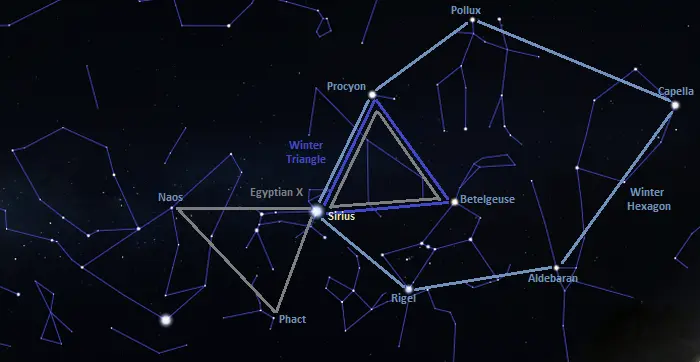
The Winter Triangle, Winter Hexagon and Egyptian Cross, as seen from equatorial latitudes, image: Stellarium
Canis Major stars
Canis Major is one of the brighter constellations. It hosts Sirius, the brightest star in the night sky, and four second magnitude stars: Adhara, Wezen, Mirzam, and Aludra. These stars are visible even from light-polluted areas.
Sirius is found by extending a line through the three bright stars of Orion’s Belt. Mirzam appears close to the Dog Star in the sky, and Adhara, Wezen and Aludra form a prominent triangle southeast of Sirius.
Sirius is the only one of these stars that will not end its life as a supernova. Even though it has twice the Sun’s mass and is 25.4 times more luminous, the star appears so bright in Earth’s sky mainly because it is one of our nearest neighbours.
Adhara, Wezen, Mirzam, Aludra, and many other visible stars in Canis Major are supernova candidates. These massive stars have already evolved away from the main sequence, while Sirius is still fusing hydrogen into helium in its core. Due to its lower mass, Sirius will still be here long after these luminous giants and supergiants are gone.
Sirius – α Canis Majoris (Alpha Canis Majoris)
Sirius (α CMa), also known as the Dog Star, is the brightest star in the sky. It is the fifth nearest star system to the Sun, the seventh individual closest star, the nearest A-type star, and the second nearest visible star to Earth, after Alpha Centauri. It appears almost twice as bright as Canopus, the second brightest star in the sky, located in the constellation Carina.
Sirius is the brightest star in Canis Major, with an apparent magnitude of -1.46. It lies 8.60 light-years away. Procyon, the lucida of Canis Minor (the Little Dog) is likely its closest stellar neighbour. The two bright stars are separated by about 5.2 light-years.
Sirius is part of a binary system. It has a dim companion, a white dwarf star nicknamed the Pup, invisible to the unaided eye. Designated Alpha Canis Majoris B (or simply Sirius B), the stellar remnant is the nearest known white dwarf to the Sun. It has an apparent magnitude of 8.44.
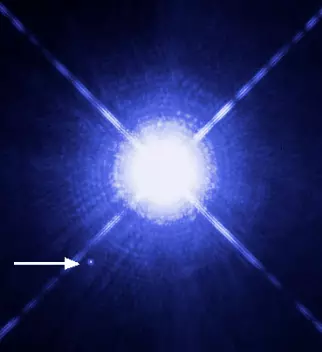
This Hubble Space Telescope image shows Sirius A, the brightest star in our nighttime sky, along with its faint, tiny stellar companion, Sirius B. Astronomers overexposed the image of Sirius A [at centre] so that the dim Sirius B [tiny dot at lower left] could be seen. The cross-shaped diffraction spikes and concentric rings around A*, and the small ring around Sirius B, are artifacts produced within the telescope’s imaging system. The image was taken with Hubble’s Wide Field Planetary Camera 2. Credit: ESA, NASA, H. Bond (STScI) and M. Barstow (University of Leicester) (PD)
With an effective temperature of 9,940 K, Sirius is one of the hottest stars in the Sun’s neighbourhood. It shines with 25.4 solar luminosities and spins at 16 km/s. It has an estimated age of 242 million years.
Sirius B, the Pup Star, is a white dwarf of the spectral type DA2. It orbits Sirius A with a period of 50.1284 years at a distance that varies between 8.2 and 31.5 astronomical units.
Sirius B has a temperature of around 25,000 K. It is one of the most massive white dwarfs known. It has 101.8% of the Sun’s mass packed into a radius of 0.0084 solar radii, which is comparable to the radius of Earth. Like all stellar remnants, it is exceptionally dense. White dwarfs have a density about 200,000 times that of Earth.
Sirius B has an estimated age of 228 million years. Astronomers believe that it was once a hot, blue, B-type star with a mass 5 times that of the Sun. As the more massive star in the Alpha Canis Majoris system, it evolved faster than Sirius and passed through the red giant stage around 120 million years ago. Eventually it expelled its outer gaseous envelope and is now fading away as a white dwarf.
The name Sirius comes from the Greek Σείριος (Seirios), meaning “scorching,” “glowing” or “searing.” In ancient times, the star rose just before sunrise during the hottest summer period, the “dog days” of summer. Ancient Greeks and Romans believed that Sirius was somehow responsible for the summer heat.
In ancient Egypt, Sirius marked the flooding of the Nile. The star’s heliacal rising, just before the annual flooding and the summer solstice, played a crucial role in the Egyptian calendar during the Middle Kingdom era. Some suggest that ancient Egyptians associated Sirius with the god Osiris.
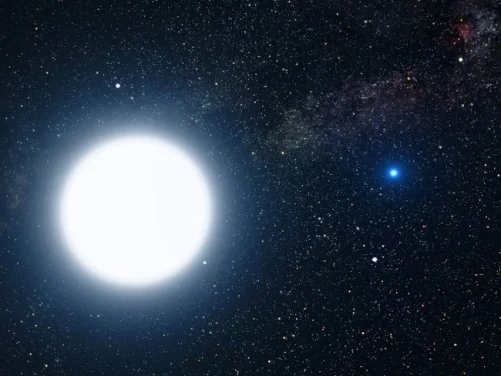
This picture is an artist’s impression showing how the binary star system of Sirius A and its diminutive blue companion, Sirius B, might appear to an interstellar visitor. The large, bluish-white star Sirius A dominates the scene, while Sirius B is the small but very hot and blue white-dwarf star on the right. The two stars revolve around each other every 50 years. White dwarfs are the leftover remnants of stars similar to our Sun. The Sirius system, only 8.6 light-years from Earth, is the fifth closest stellar system known. Sirius B is faint because of its tiny size. Its diameter is only 7,500 miles (about 12 thousand kilometres), slightly smaller than the size of our Earth. The Sirius system is so close to Earth that most of the familiar constellations would have nearly the same appearance as in our own sky. In this rendition, we see in the background the three bright stars that make up the Summer Triangle: Altair, Deneb, and Vega. Altair is the white dot above Sirius A; Deneb is the dot to the upper right; and Vega lies below Sirius B. But there is one unfamiliar addition to the constellations: our own Sun is the second-magnitude star, shown as a small dot just below and to the right of Sirius A. Image: NASA, ESA. Credit: G. Bacon (STScI) (PD)
Adhara – ε Canis Majoris (Epsilon Canis Majoris)
Adhara (ε CMa) is the second brightest star in Canis Major and the 22nd brightest star in the night sky. It is a binary star that lies around 430 light-years away. Epsilon CMa has an apparent magnitude of 1.50 and is the brightest second magnitude star, narrowly outshining Castor in Gemini.
The primary component in the system, Epsilon Canis Majoris A, is a bright giant star of the spectral type B2 II. The hot blue star has a mass of around 12.6 solar masses and a radius 10.5 times that of the Sun. It spins at 25 km/s, taking about 5 days to complete a rotation.
Adhara is 38,700 times more luminous than the Sun, with an effective temperature of 22,900 K. It has an estimated age of 17.5 – 19 million years.
Even though it is still a young star, Epsilon CMa will not have a very long life. It has already burned through its supply of hydrogen in its core and it will not be long before it goes out as a bright supernova.
The companion, Epsilon Canis Majoris B, has an apparent magnitude of 7.5 and appears 7.5 arcseconds from the primary.
The name Adhara comes from the Arabic aðāra, meaning “virgins.” In Arabic astronomy, Adhara formed an asterism known as the Virgins (Al ʽAdhārā) with Wezen (Delta CMa), Aludra (Eta CMa), and Omicron2 Canis Majoris.
About 4.7 million years ago, Adhara was the brightest star in the sky. It was only 34 light years distant and had a visual magnitude of -3.99. No other star has ever been as bright since, nor is one expected to be in the next five million years.
Wezen – δ Canis Majoris (Delta Canis Majoris)
Wezen (δ CMa) is a yellow-white F-type supergiant approximately 1,600 light years distant. It has the stellar classification F8 Ia. With an apparent magnitude of 1.824, it is the third brightest star in Canis Major.
Wezen appears about 10 degrees southeast of Sirius. It is the northernmost star in the triangle also formed by Adhara and Aludra.
The supergiant star has a mass 14.9 times that of the Sun and a radius of 188 solar radii. It is 37,500 – 51,000 times more luminous than the Sun.
Wezen is a young star, with an estimated age of only 12 million years. Like its bright neighbours Adhara and Aludra, it is a supernova candidate.
Delta CMa will become a red supergiant in the next 100,000 years and eventually its core will collapse, triggering a supernova event.
The name Wezen is derived from the Arabic al-wazn, meaning “the weight.” The name of Beta Columbae, Wazn, has the same etymology.
Mirzam – β Canis Majoris (Beta Canis Majoris)
Mirzam (β CMa) is a variable blue giant or bright giant located approximately 490 light-years away. It has an apparent magnitude that varies between 1.97 and 2.01. The star was traditionally also known as Al-Murzim or Murzim. It appears near the bright star Sirius in the sky.
The blue-white giant has the stellar classification B1 II-III. It has an estimated mass of 12 – 12.6 solar masses and a radius of 7.4 – 8.2 times that of the Sun. With an effective temperature of 24,700 K, it shines with 25,700 solar luminosities. The star spins at 31 km/s and takes 13.6 days to complete a rotation. It has an estimated age of 12.2 or 13.8 million years.
The name Mirzam comes from the Arabic word for “the herald.” It refers to Mirzam’s position in the sky. The star rises before, i.e. it heralds Sirius.
Mirzam is classified as a Beta Cephei variable, a star that exhibits variations in brightness as a result of pulsations of its surface. The brightness of Beta CMa varies between magnitude 1.97 and 2.01 over a period of six hours. The variations cannot be discerned by the human eye.
Mirzam is believed to have been the brightest star in Earth’s sky around 4.42 million years ago. At the time, it shone at magnitude -3.65.
Aludra – η Canis Majoris (Eta Canis Majoris)
Aludra (η CMa) is a hot blue supergiant of the spectral type B5 Ia. It lies approximately 2,000 light-years away and has an apparent magnitude of 2.450. It is around 8.3 million years old.
The luminous star has 18.19 times the Sun’s mass and a radius 54 times that of the Sun. It is between 135,000 and 174,000 times more luminous than the Sun, with a surface temperature of 15,000 – 16,000 K.
Eta CMa is classified as an Alpha Cygni variable. Like Deneb (Alpha Cygni) in the constellation Cygnus, it is among the most luminous stars visible to the unaided eye. Alpha Cygni stars vary in brightness due to radial pulsations. They are hot, massive supergiants of spectral types A or B. The brightness of Aludra has been observed to vary between magnitude 2.38 and 2.48 over a period of 4.7 days.
Even though it is a very young star, Aludra is already approaching the final stages of its life. It is expected to go out as a supernova within the next few million years.
The star’s name is derived from the Arabic al-‘aðrā, meaning “the virgin.” Aludra was one of the stars known as the Virgins, along with Adhara, Wezen and Omicron2 Canis Majoris.
Furud – ζ Canis Majoris (Zeta Canis Majoris)
Furud (ζ CMa) is a binary star located 362 light-years away. It shines at magnitude 3.025. The name Furud (historically also spelled Phurud) comes from the Arabic phrase al-furud, meaning “the solitary ones.”
Zeta CMa is a single-lined spectroscopic binary system, which means that the two components appear so close together that they cannot be resolved with a telescope. The system’s binarity can only be discerned by shifts in the spectrum of the primary component. The two components orbit each other with a period of 675 days.
The primary star, Zeta Canis Majoris A, is a hot, massive main sequence star of the spectral type B2.5 V. It has a mass 7.7 times that of the Sun and a radius 3.9 times solar. It shines with 3,603 solar luminosities with an effective temperature of 18,700 K. The star has an estimated age of 32 million years.
τ Canis Majoris (Tau Canis Majoris)
Tau Canis Majoris (τ CMa) is a massive multiple star system located approximately 5,120 light-years (1,570 parsecs) away. The system has a combined apparent magnitude of 4.40. It is the brightest member of the open cluster NGC 2362 (Caldwell 64), also known as the Tau Canis Majoris Cluster.
Tau CMa is sometimes called the “Mexican Jumping Star” because it is so much brighter than other members of NGC 2362 that it can appear to “jump around” when seen in a telescope.
The Tau Canis Majoris system has the stellar classification O9II, indicating a blue bright giant. The primary component, Tau Canis Majoris A, is a spectroscopic binary star with an orbital period of 154.918 days.
The fainter component of Tau CMa A is itself a short period eclipsing binary star classified as a Beta Lyrae variable. Beta Lyrae stars are massive giants and supergiants that are so close together that their shapes are highly distorted by mutual gravity. These stars appear ellipsoidal and material flows from one component to the other. Beta Lyrae systems vary in brightness because the components eclipse each other as they orbit.
Tau Canis Majoris Ab1 and Ab2 are believed to be B-type main sequence stars with masses around 17.8 times that of the Sun.
Tau Canis Majoris Aa, the primary component of the Tau CMa system, is thought to have a mass 50 times that of the Sun and a radius of 19.8 solar radii. With a surface temperature of 32,000 K, the bright giant star is 280,000 times more luminous than the Sun.
The properties of other components are uncertain. Tau CMa B shines at 10th magnitude and appears 8.6 arcseconds from the primary. If Tau CMa A and B are gravitationally bound, they have an orbital period of 94,000 years.
Tau CMa C is a 14th magnitude star at a separation of 14.2 arcseconds, and the component Tau CMa D appears 85 seconds of arc away and shines at 8th magnitude.
VY Canis Majoris
VY Canis Majoris is a red hypergiant with the stellar classification M5Iae. With a radius about 1,420 times that of the Sun, it is one of the largest stars known. The behemoth lies approximately 3,820 light-years away. If the star replaced the Sun in our solar system, it would stretch beyond the orbit of Jupiter.
The hypergiant star is only 8.2 million years old, but it has evolved quickly because of its high mass. It has 17 times the Sun’s mass, which seals its fate as a luminous supernova in the relatively near future. The star is highly unstable and experiencing enormous mass loss. It is surrounded by a thick envelope of ejected material. Like Betelgeuse in Orion, it is expected to go out as a supernova in the next 100,000 years.
With an effective temperature of 3,490 K, VY CMa is about 178,000 times more luminous than the Sun. It is one of the most massive and luminous red supergiants known.
The brightness of VY Canis Majoris has been observed to vary between magnitude 6.5 and 9.6. The star is classified as either a semiregular variable or a slow irregular variable. It is a pulsating star with an estimated period of 956 days.
VY Canis Majoris is embedded in Sh2-310, a large star-forming region about 681 light-years across.
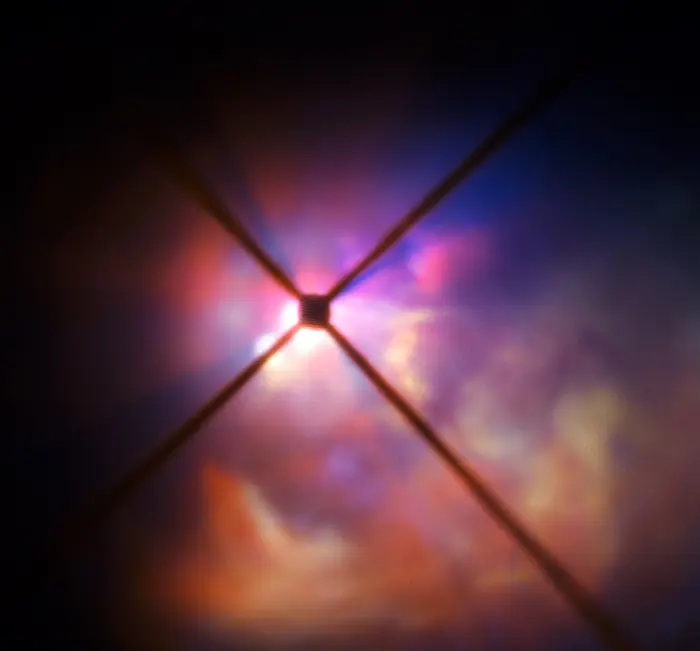
The star VY Canis Majoris is a red hypergiant, one of the largest known stars in the Milky Way. It is 30–40 times the mass of the Sun and 300 000 times more luminous. In its current state, the star would encompass the orbit of Jupiter, having expanded tremendously as it enters the final stages of its life. Observations of the star using the SPHERE instrument on the VLT have clearly revealed how the brilliant light of VY Canis Majoris lights up the clouds of material surrounding it and have allowed the properties of the component dust grains to be determined better than ever before. In this very close-up view from SPHERE the star itself is hidden behind an obscuring disc. The crosses are artefacts due to features in the instrument. Image credit: ESO (CC BY 4.0)
EZ Canis Majoris
EZ Canis Majoris is a binary star system composed of a Wolf-Rayet star and a smaller companion. The system is located approximately 4,900 light-years away. The two components are locked in a 3.63-day orbit at a separation of only 0.13 astronomical units. The system’s brightness varies from magnitude 6.71 to 6.95.
The Wolf-Rayet star has 23 times the Sun’s mass and a radius of 3.25 solar radii. With a surface temperature of 89,100 K, it is 620,000 times more luminous than the Sun. The companion has a mass of 1.5 solar masses.
EZ Canis Majoris is likely a member of the open cluster Collinder 121. The star system is surrounded by the faint nebula Sh2-308, nicknamed the Dolphin-Head Nebula. The bubble nebula consists of material expelled from EZ CMa 70,000 years ago and is ionized by the powerful ultraviolet radiation from the luminous star.
The EZ Canis Majoris system is a suspected dwarf nova (Z Camelopardalis variable), a variable system in which a white dwarf accretes material from a more massive companion, causing occasional outbursts.
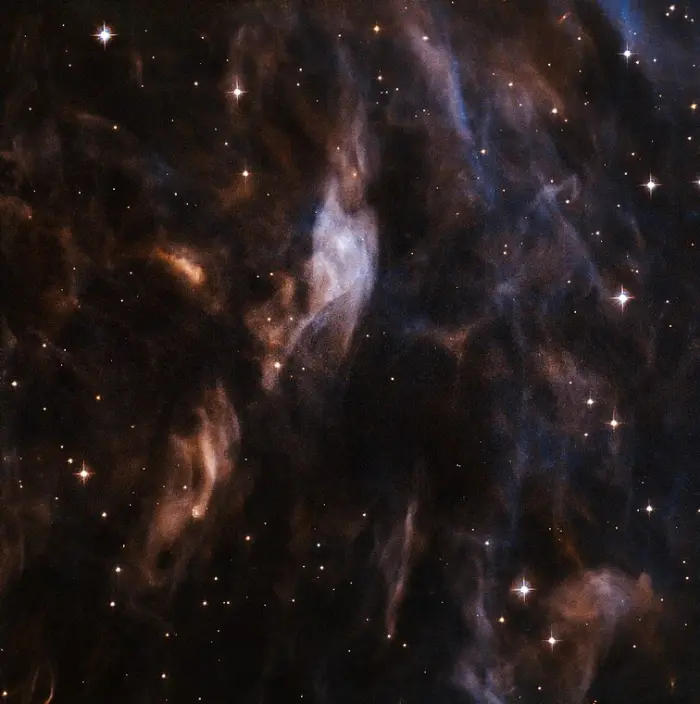
The NASA/ESA Hubble Space Telescope still has a few tricks up its sleeve in its task of exploring the Universe. For one, it is able to image two adjacent parts of the sky simultaneously. It does this using two different cameras — one camera can be trained on the target object itself, and the other on a nearby patch of sky so that new and potentially interesting regions of the cosmos can be observed at the same time (these latter observations are known as parallel fields). This image shows part of a bubble-like cloud of gas — a nebula named Sh2-308 — surrounding a massive star named EZ Canis Majoris. It uses observations from Hubble’s Advanced Camera for Surveys, and is the parallel field associated with another view of the nebula produced by Hubble’s Wide Field Camera 3. EZ Canis Majoris is something known as a Wolf-Rayet star, and is one of the brightest known stars of its kind. Its outer shell of hydrogen gas has been used up, revealing inner layers of heavier elements that burn at ferocious temperatures. The intense radiation pouring out from EZ Canis Majoris forms thick stellar winds that whip up nearby material, sculpting and blowing it outwards. These processes have moulded the surrounding gas into a vast bubble. A bubble nebula produced by a Wolf-Rayet star is made of ionised hydrogen (HII), which is often found in interstellar space. In this case, it is the outer hydrogen layers of EZ Canis Majoris — the bubble — that are being inflated by the deluge of radiation — the air — coming from the central star. The fringes of these bubbles are nebulous and wispy, as can be seen in this image. Image credit: ESA/Hubble & NASA (CC BY 4.0)
Unurgunite (Sigma Canis Majoris)
Unurgunite (σ CMa) is a variable orange supergiant of the spectral type K5 Ib. It is located approximately 1,290 light-years away and has an apparent magnitude of 3.43 – 3.51.
The star has 5.61 times the Sun’s mass and a radius about 258 times that of the Sun, larger than the distance between the Earth and the Sun. With a surface temperature of 3,792 K, the supergiant star is 12,300 times more luminous than the Sun. It has an estimated age of 83.2 million years.
More recent sources give a mass of 8.4 solar masses, which would make Sigma CMa a supernova candidate.
Unurgunite is classified as a slow irregular variable (type LC). Type LC variables are supergiants of late spectral classes. These stars vary in brightness without a discernible period. They include Enif in the constellation Pegasus, Antares in Scorpius, Omicron1 Canis Majoris in Canis Major, and Suhail in Vela.
The name Unurgunite comes from the Boorong people of northwestern Victoria in Australia. In Boorong culture, the star is associated with the Jacky lizard (nganurganity), an ancestral figure flanked by his wives, represented by the stars Adhara and Wezen.
Omicron1 Canis Majoris
Omicron1 Canis Majoris is an orange supergiant star that shines at magnitude 3.87 from a distance of 2,673 light-years. It has the stellar classification K2.5 Iab. Like Unurgunite, it is classified as a slow irregular variable (LC).
Omicron1 CMa has a mass 7.83 times that of the Sun and a radius 390 times the Sun’s. With a surface temperature of 4,105 K, it shines with 37,414 solar luminosities. Even though it is a highly evolved star, it is still very young. It has an estimated age of only 18 million years.
The star shares the Bayer designation Omicron Canis Majoris with the brighter Omicron2 Canis Majoris. However, the two stars are only visual companions. They lie at different distances and are not physically related.
Omicron2 Canis Majoris
Omicron2 Canis Majoris is a hot blue supergiant of the spectral type B3 Ia. It lies approximately 3,590 light-years away and shines at magnitude 3.043.
The supergiant star has a mass of 21.4 solar masses and will likely go out as a type II supernova when it comes to the end of its life cycle. It has a radius 65 times that of the Sun and shines with 220,000 solar luminosities. It has a surface temperature of 15,500 K and is believed to be only 7.4 million years old.
Omicron2 Canis Majoris is classified as an Alpha Cygni variable. Like Deneb (Alpha Cygni) in the constellation Cygnus, it is one of the most luminous stars visible to the unaided eye. Alpha Cygni stars vary in brightness because they are pulsating stars. The brightness of Omicron2 CMa has been observed to vary between magnitude 2.93 and 3.08 with a period of 24.44 days.
The star does not have a formal name approved by the International Astronomical Union (IAU). It was traditionally known as Thanih al Adzari, “the second virgin.” The name was translated into Latin as Secunda Virginum.
UW Canis Majoris
UW Canis Majoris is a massive binary system located approximately 3,800 light-years away. It is composed of two hot, blue supergiants of the spectral types O7.5-8Iabf and O9.7Ib. It has an average apparent magnitude of 4.95.
The two components orbit each other from a distance of only 34-48 solar radii with a period of 4.39 days. The system is classified as a Beta Lyrae variable, a close binary star consisting of large, massive components that periodically eclipse each other during their orbit. The brightness of UW CMa varies from magnitude 4.84 to 5.33 with a period of 4.39 days, corresponding to the system’s orbital period.
UW Canis Majoris is a contact binary star. The two components touch each other and share their gaseous envelopes.
The parameters of the components are uncertain. The primary component has a mass between 11 and 44 times that of the Sun and a radius of 12 to 20 solar radii. It has an effective temperature of 33,750 K and is between 170,000 and 450,000 times more luminous than the Sun.
The secondary star has between 17 and 33 times the Sun’s mass and a radius between 14 and 17 times that of the Sun. With a surface temperature between 33,300 and 33,700 K, it shines with 240,000 to 330,000 solar luminosities.
The system is part of the HII region Sh2-310. It is partly responsible for ionizing the nebula, along with VY Canis Majoris and Tau Canis Majoris.
Muliphein – γ Canis Majoris (Gamma Canis Majoris)
Muliphein (γ CMa) is a blue-white bright giant of the spectral type B8II, located approximately 440 light-years away. It has an apparent magnitude of 4.10.
The name Muliphein comes from the Arabic muħlifayn, which refers to “two things” and “the swearing of an oath.” Gamma CMa traditionally shared the name with the brighter Gamma Centauri (Muhlifain) in the constellation Centaurus, but the International Astronomical Union (IAU) only approved the name for the Canis Major star.
Muliphein is a chemically peculiar star that exhibits abnormal lines of magnesium and mercury. It has a radius 5.6 times that of the Sun and shines with 715 solar luminosities with an effective temperature of 13,596 K.
The star may be a spectroscopic binary system. It is a member of the bright open cluster Collinder 121.
Amadioha – HD 43197
Amadioha (HD 43197) is a star of the spectral type G8/K0 IV/V, indicating a yellow or orange subgiant or main sequence star. The star lies 203.6 light-years away. With an apparent magnitude of 8.98, it is invisible to the unaided eye.
HD 43197 has a mass and radius similar to the Sun (1.02 solar masses, 0.96 solar radii). With an effective temperature of 5,469 K, it is slightly cooler than the Sun and shines with 74% of the Sun’s luminosity.
The star spins at 2.18 km/s, a little faster than the Sun. It has an estimated age of 3.1 billion years.
HD 43197 was named Amadioha during the International Astronomical Union’s 2019 NameExoWorlds campaign. The name comes from Nigeria. Amadioha is the god of thunder and lightning in Igbo mythology.
Amadioha hosts two planets, HD 43197 b and HD 43197 c.
HD 43179 b was discovered in 2009. It is a Jupiter-like planet that orbits in the parent star’s habitable zone 78% of the time. The planet has a mass at least 55% that of Jupiter. It has a highly eccentric orbit. It orbits the star at a semimajor axis of 0.882 astronomical units, taking 0.85 years to complete an orbit.
The planet was named Equiano, after Nigerian author and abolitionist Olaudah Equiano, in the 2019 NameExoWorlds campaign.
HD 43197 c is a super-Jovian planet discovered in 2022. It has a mass of about 7.868 Jupiter masses and orbits HD 43197 at a distance of 8.54 AU, taking 9,296 days to complete an orbit.
Atakoraka – WASP-64
Atakoraka (WASP-64) is a yellow dwarf of the spectral type G7. It hosts an exoplanet, WASP-64 b, formally named Agouto.
The star lies 1,220 light-years away and has an apparent magnitude of 12.29. It is invisible to the unaided eye. It was named after the Atakora mountains in Togo during the NameExoWorlds campaign in 2019. The planet was named Agouto after Mount Agou, the highest point of Togo.
WASP-64 is similar to the Sun. It has 99.3% of the Sun’s mass and a radius of 1.036 solar radii. It shines with 90% of the Sun’s luminosity with a surface temperature of 5,400 K. The star has an estimated age of 3.554 billion years.
The planet WASP-64 b is a hot Jupiter that orbits the host star with a period of only 1.573253 days.
RX J0720.4−3125
RX J0720.4−3125 is a neutron star discovered in 1997. It lies approximately 1,200 light-years (360 parsecs) away. The stellar remnant has a radius of about 5 kilometres. The spectrum and temperature of RX J0720.4−3125 have been observed to change over several years. The reason for the changes is uncertain.
RX J0720.4−3125 is one of the Magnificent Seven, a group of isolated neutron stars that lie relatively close by. The seven neutron stars are also known as XDINS or XINS (X-ray Dim Isolated Neutron Stars).
Deep sky objects in Canis Major
The constellation Canis Major hosts several relatively bright deep sky objects visible in amateur telescopes. It contains one open star cluster listed in the Messier catalogue – the open cluster Messier 41 (the Little Beehive Cluster) – and two open clusters listed in the Caldwell catalogue, Caroline’s Cluster (NGC 2360, Caldwell 58) and the Tau Canis Majoris Cluster (NGC 2362, Caldwell 64).
Four deep sky objects in Canis Major are listed in the Herschel 400 catalogue: the open clusters NGC 2204, NGC 2354, NGC 2360 (Caroline’s Cluster), and NGC 2362 (the Tau Canis Majoris Cluster).
Messier 41 (M41, NGC 2287)
Messier 41 (M41) is an open cluster that appears four degrees south of Sirius. It lies 2,300 light-years away. It has an apparent visual magnitude of 4.5 and an apparent size of 38 arcminutes, comparable to that of the full Moon.
The cluster was discovered by the Italian astronomer Giovanni Battista Hodierna before 1654. It may have been recorded by ancient Greek philosopher Aristotle around 325 BCE. It has been nicknamed the Little Beehive Cluster because of its resemblance to the brighter and larger Beehive Cluster (Messier 44) in the zodiac constellation Cancer.
Messier 41 contains about 100 stars. Several members are red giants, the brightest of which is a magnitude 6.3 K3-type giant located near the centre of the cluster.
M41 is 25-26 light years in diameter. It has an estimated age of 190 million years. It will be another 300 million years before the cluster disintegrates.
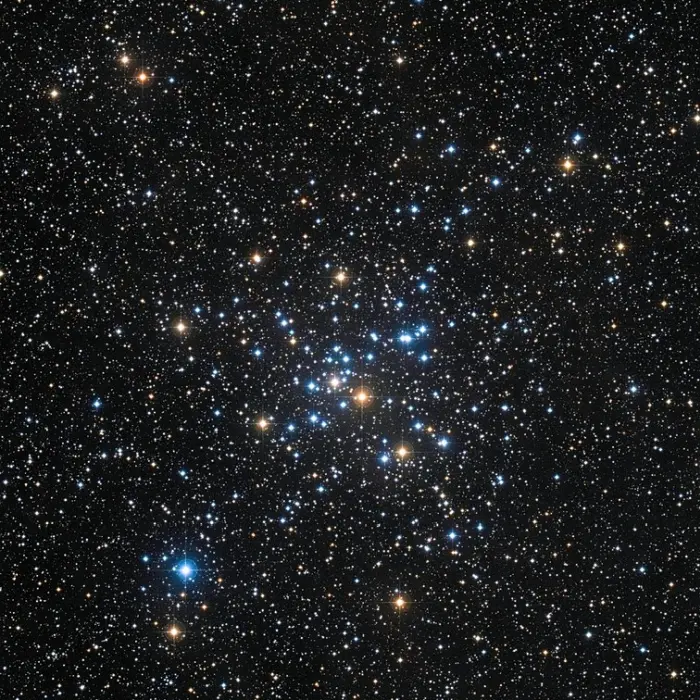
The Little Beehive Cluster (Messier 41), image credit: Giuseppe Donatiello (CC0 1.0)
Caroline’s Cluster (NGC 2360)
Caroline’s Cluster is an open cluster with an apparent magnitude of 7.2 and an apparent size of 13 arcminutes. It is catalogued as NGC 2360 in the New General Catalogue and Caldwell 58 in Sir Patrick Moore’s Caldwell catalogue. The cluster appears 3.5 degrees east of Muliphein (Gamma CMa). It has an estimated age of 2.2 billion years.
NGC 2360 is about 15 light-years across. It was named Caroline’s Cluster after its discoverer, the German-born British astronomer Caroline Herschel, who spotted it on February 26, 1783. Her brother William Herschel added the cluster to his 1786 catalogue, crediting her for the discovery.
The cluster lies approximately 3,700 light-years away. It should not be mistaken for the brighter and larger Caroline’s Rose Cluster (the White Rose Cluster, NGC 7789), an open cluster located in the northern constellation Cassiopeia.
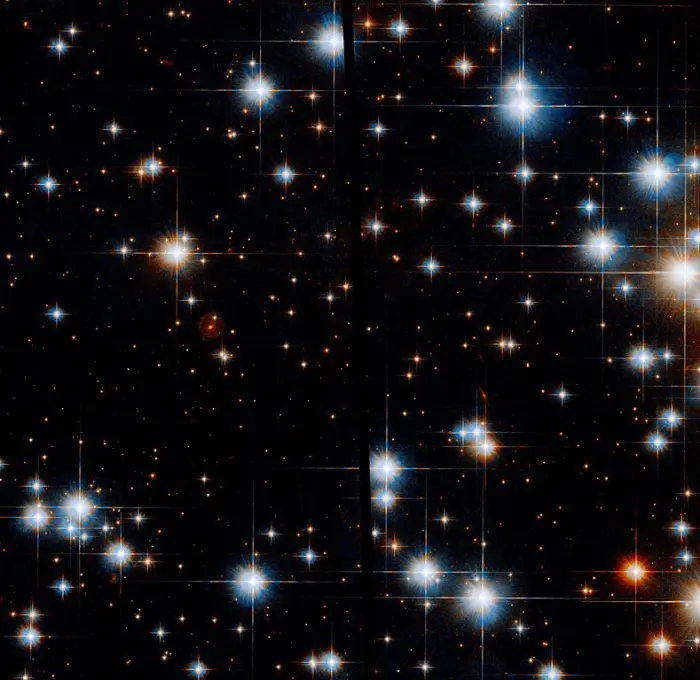
Caldwell 58, also known as NGC 2360 or Caroline’s Cluster, was discovered by and named after the German astronomer Caroline Herschel in 1783. The younger sister of famed astronomer William Herschel, Caroline was the first woman to win the prestigious Gold Medal of the Royal Astronomical Society. She earned this award for her work verifying her brother’s astronomical observations and compiling a catalog of nebulae to aid other astronomers. Astronomers used Hubble to study white dwarfs in Caldwell 58 and better understand the age of our galaxy. After a Sun-like star has exhausted its supply of nuclear fuel and ejected its outer layers of gas, what is left behind is the hot core of the star — a white dwarf. These objects cool over a period of billions of years and are some of the oldest stars in our galaxy. Some white dwarfs pulse regularly as they cool. The time between these pulsations changes over the white dwarf’s lifetime, so the time between pulses can be used to estimate how quickly the white dwarf is cooling, and thus how long it has been cooling. This information is useful to astronomers because it means pulsating white dwarfs can be used as chronometers, or “clocks,” that constrain the age of our galaxy. These observations of Caldwell 58 were made with Hubble’s Advanced Camera for Surveys to help astronomers calibrate white-dwarf chronometers. Credit: NASA, ESA, and T. von Hippel (Embry-Riddle Aeronautical University); Processing: Gladys Kober (NASA/Catholic University of America) (CC BY 2.0)
Tau Canis Majoris Cluster (NGC 2362)
The Tau Canis Majoris Cluster (NGC 2362, Caldwell 64) is an open cluster located 4,830 light-years away. It appears near the triangle formed by Wezen, Adhara and Aludra. With an apparent magnitude of 3.8 and an apparent size of 6 arcminutes, the cluster is visible to the unaided eye in good conditions.
The Tau Canis Majoris Cluster was discovered by Italian astronomer Giovanni Battista Hodierna before 1654. It is named after its brightest member, the magnitude 4.40 O-type bright giant Tau Canis Majoris. Tau CMa is a multiple star system composed of several exceptionally hot and massive O- and B-type stars that are destined to go out as luminous supernovae.
NGC 2362 contains 100 – 150 stars and has a mass of over 500 solar masses. It has an estimated age of only 5 million years. The cluster is associated with the giant molecular cloud Sh2-310. The brighter members of the cluster ionize the vast H II region and make it glow.
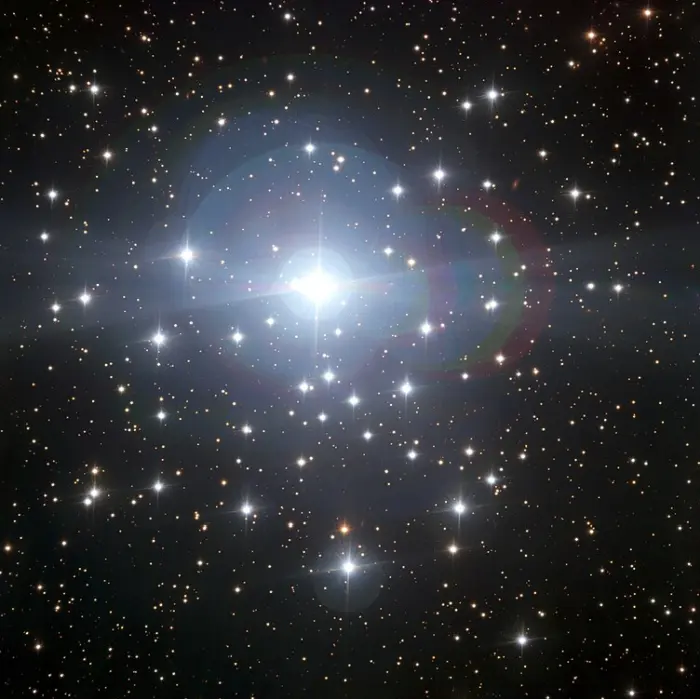
The Tau Canis Majoris Cluster is an open cluster — a group of stars born from the same molecular cloud. This means that all of the cluster’s inhabitants share a common chemical composition and are loosely bound together by gravity. Having been born together, they make an ideal stellar laboratory to test theories of stellar evolution, the chain of events that leads from a star’s birth in a cool, dense cloud of gas through to its eventual end. Though the stars in this image were all created at the same time, their various different masses mean they will lead very different lives. As Tau Canis Majoris is one of the most massive and short-lived types of star, it will burn through its nuclear fuel long before its smaller companions, which will keep on shining for billions of years. This image was created as part of the ESO Cosmic Gems programme, an outreach initiative to produce images of interesting, intriguing or visually attractive objects using ESO telescopes, for the purposes of education and public outreach. Image credit: ESO (CC BY 4.0)
NGC 2204
NGC 2204 is an open star cluster located approximately 13,400 light-years away. It shines at magnitude 8.6 and has an apparent size of 11.8 by 11.8 minutes of arc, corresponding to a physical diameter or about 55 light-years.
The cluster is diffuse, but rich. It is one of the relatively bright deep sky objects included on the Herschel 400 observing list. It has an estimated age of 2 billion years. Some of its stars have merged, producing blue stragglers. These stars appear younger, bluer and more luminous than other members of the cluster.
NGC 2204 was discovered by William Herschel on February 6, 1785.
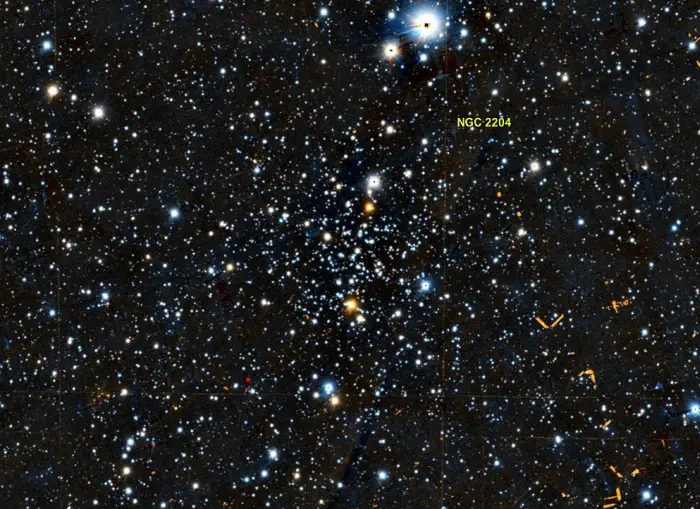
NGC 2204, image created using the Aladin Sky Atlas software from the Strasbourg Astronomical Data Center and
Pan-STARRS (Panoramic Survey Telescope And Rapid Response System), credit: Donald Pelletier (CC BY-SA 4.0)
NGC 2354
NGC 2354 is an open cluster with an apparent magnitude of 6.5 and an angular size of 18.2 by 18.2 arcminutes. It appears 2 degrees southwest of the brighter Tau Canis Majoris Cluster, roughly halfway between Tau Canis Majoris and Wezen (Delta CMa).
The cluster can be seen binoculars, which resolve about 15 of its brightest stars. It was discovered by William Herschel on March 6, 1785. It is also catalogued as Collinder 131.
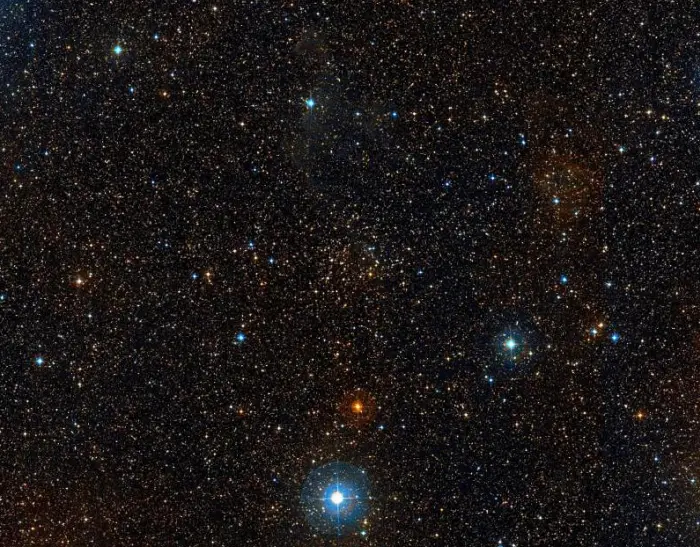
NGC 2354, image: Wikisky (DSS2)
Canis Major Dwarf Galaxy
The Canis Major Dwarf Galaxy (CMa Dwarf) is a disputed galaxy that lies in the same region of the sky as the constellation Canis Major. The dwarf irregular galaxy is a difficult object to observe because it lies behind the plane of the Milky Way, and is obscured by stars, dust and gas.
The nature of the object is still uncertain, which is why it is commonly referred to as the Canis Major Overdensity. Some believe that it is the remnant of a satellite galaxy, while others claim that it is part of the Milky Way.
The galaxy stretches across 12 degrees and contains about 1 billion stars, among them a significant number of red giants. It lies 25,000 light-years from Earth and 42,000 light-years from the Galactic Centre.
There are a number of globular clusters associated with the Canis Major Dwarf, among them NGC 1851 (Caldwell 73) in the constellation Columba, Messier 79 (NGC 1904) in Lepus, NGC 2298 in Puppis, and NGC 2808 in Carina. These clusters are thought to be remnants of the dwarf galaxy’s globular cluster system before the galaxy started getting pulled apart and absorbed into the Milky Way.
The Canis Major Dwarf was discovered by an international team of astronomers in 2003. At the time, it was believed to be the nearest galaxy to Earth, closer to us than the centre of our own galaxy. The galaxy was described as an elliptical stellar overdensity. Some astronomers believe it to be a dwarf galaxy whose main body is severely degraded because it is being pulled apart by the Milky Way’s gravitational field.
A stellar stream pulled from the galaxy by the Milky Way’s tidal forces is known as the Monoceros Ring. The stream is 200 light-years long and wraps around our galaxy three times. Some studies have suggested that the ring is really part of the Milky Way’s disk and not the result of a smaller satellite galaxy being accreted by the Milky Way.
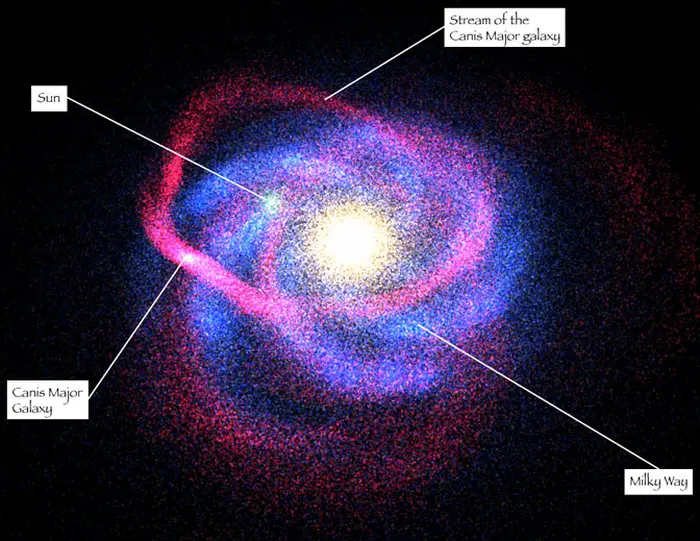
Canis Major Dwarf Galaxy, image credit: R. Ibata .- 2MASS, NASA (PD)
Thor’s Helmet Nebula (NGC 2359)
NGC 2359 is an emission nebula located approximately 11,960 light-years away in Canis Major. Nicknamed the Duck Nebula or Thor’s Helmet Nebula, the H II region is 30 light-years across and surrounds the massive Wolf-Rayet star WR7 (HD 56925).
WR7 is thought to be in the pre-supernova stage of its life cycle. The star has a mass 13 times that of the Sun and is partly responsible for ionizing the nebula’s gas.
Thor’s Helmet has a bubble shape, but appears more complex than the similar Bubble Nebula (NGC 7635) in the constellation Cassiopeia because it is interacting with a nearby molecular cloud. Different parts of the nebula are expanding at a rate from 10 km/s to 30 km/s, indicating an age between 78,500 and 236,000 years.
Thor’s Helmet Nebula is also catalogued as Gum 4 and Sharpless 2-298 (Sh2-298).
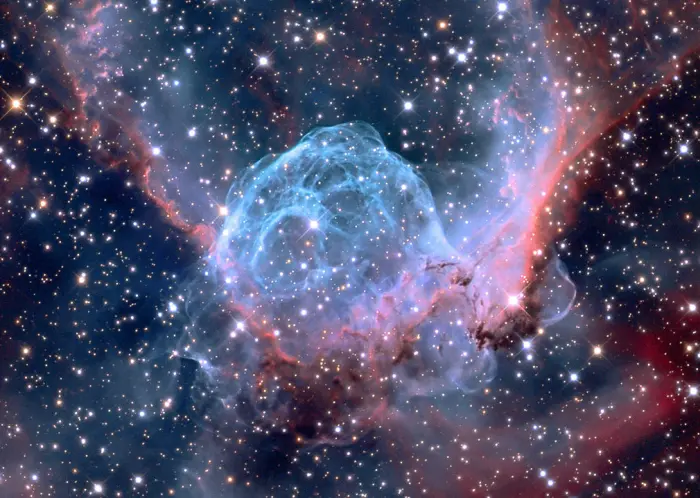
Thor’s Helmet Nebula, image credit: Adam Block/Mount Lemmon SkyCenter/University of Arizona (CC BY-SA 4.0)
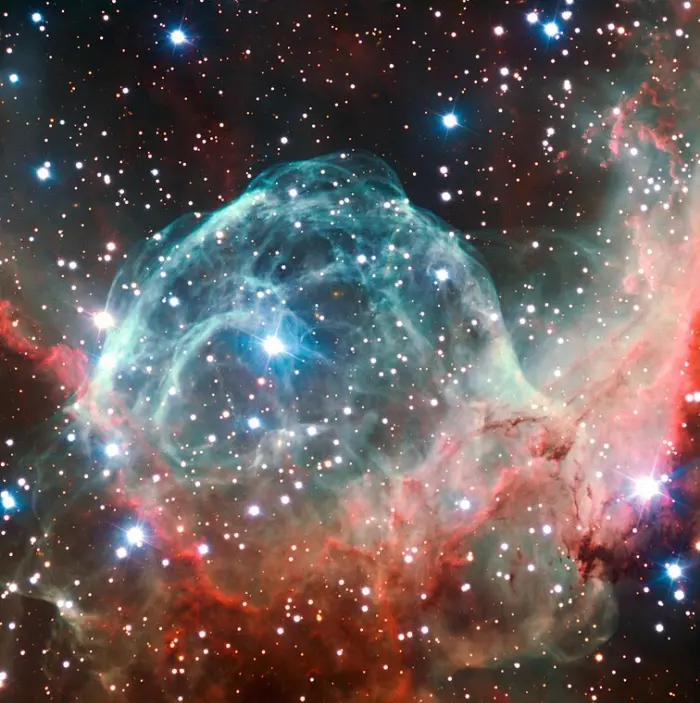
This VLT image of the Thor’s Helmet Nebula was taken on the occasion of ESO’s 50th Anniversary, 5 October 2012, with the help of Brigitte Bailleul. The observations were broadcast live over the internet from the Paranal Observatory in Chile. This object, also known as NGC 2359, lies in the constellation of Canis Major (The Great Dog). The helmet-shaped nebula is around 15 000 light-years away from Earth and is over 30 light-years across. The helmet is a cosmic bubble, blown as the wind from the bright, massive star near the bubble’s centre sweeps through the surrounding molecular cloud. Image: ESO/B. Bailleul (CC BY 4.0)
NGC 2207 and IC 2163
NGC 2207 and IC 2163 are colliding spiral galaxies in Canis Major. They lie approximately 81 million light years away. They were discovered by the English astronomer John Herschel in 1835. The interacting galaxies have apparent magnitudes of 12.2 and 11.6. NGC 2207 has an apparent size of 4.3 by 2.8 arcminutes and IC 2163 appears 3.0 by 1.2 arcminutes across.
NGC 2207 is an intermediate spiral galaxy and IC 2163 is classified as a barred spiral. Both galaxies show a weak inner ring around the central bar. The elongated spiral arm of the smaller IC 2163 is stretched out as a result of interaction with the larger neighbour. The galaxies are in the process of tidal stripping, with the larger galaxy pulling stars and other material from the smaller one.
The colliding galaxies have a great amount of gas and dust. Both are beginning to show higher rates of star formation. The galaxies are still in an early phase of merging into a single larger galaxy. As they continue to collide, they will likely begin to resemble the Mice Galaxies (NGC 4676) in the constellation Coma Berenices.
Both NGC 2207 and IC 2163 have hosted supernovae in recent decades. NGC 2207 hosted five supernova events: SN 1975A in January 1975, SN 1999ec in October 1999, SN 2003H in January 2003, SN 2013ai in March 2013, and AT 2019eet in April 2019.
IC 2163 hosted two supernovae: SPIRITS17Ib in May 2017 and SN 2018Iab in December 2018.
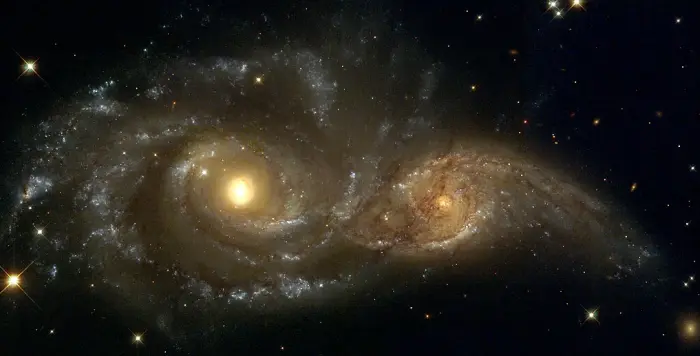
Near colliding NGC 2207 and IC 2163 as seen by the NASA/ESA Hubble Space Telescope. Image credit: NASA/ESA and The Hubble Heritage Team (STScI) (PD)
Sh2-310
Sharpless 310 (Gum 8) is a vast H II region in the eastern part of Canis Major. The star-forming nebula spans about 681 light-years (209 parsecs) and has an apparent size of 480 arcminutes. It has a low surface brightness and is a challenging object for small and medium telescopes.
Sh2-310 is one of the largest H II regions in the Milky Way galaxy. It is ionized by Tau Canis Majoris, UW Canis Majoris, and other luminous blue stars in the region. The hypergiant VY Canis Majoris appears on the nebula’s rim, but may be a foreground object.
The nebula lies on the outer edge of the Orion Arm of the Milky Way, approximately 4,900 light-years away. It is associated with several young open clusters, including NGC 2362 (the Tau Canis Majoris Cluster).
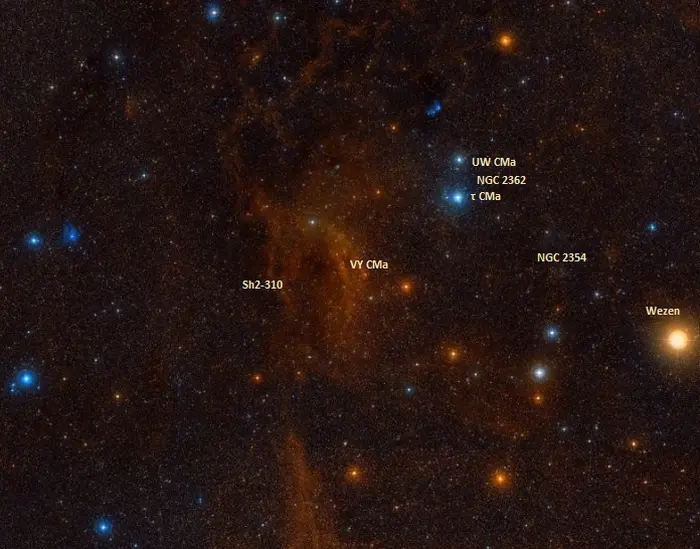
Sh2-310, image: Wikisky (DSS2)
Dolphin Head Nebula – Sh2-308
Sharpless 308 is a faint nebula that surrounds the Wolf-Rayet star EZ Canis Majoris. It has been nicknamed the Dolphin Head Nebula because its bubble shape looks like a dolphin’s head in space. The nebula lies about 4,530 light-years away and appears in the central portion of the Great Dog constellation, about 8 degrees south of Sirius. At its longest point, it is about 60 light-years across.
The Dolphin Head Nebula is composed of material expelled from the massive central Wolf-Rayet star around 70,000 years ago. EZ Canis Majoris is in a late stage of its evolutionary cycle and is losing mass at an accelerated rate. With 23 times the Sun’s mass, the young star will soon (astronomically speaking) end its life as a supernova.
The massive star has a bolometric luminosity 620,000 times that of the Sun. Most of its energy is emitted as ultraviolet radiation that ionizes the expelled material and makes it glow as a celestial Dolphin.
The Dolphin’s Head Nebula has an apparent magnitude of 7.0 and an angular size of 35 arcminutes. It is best viewed at high magnification with filters.
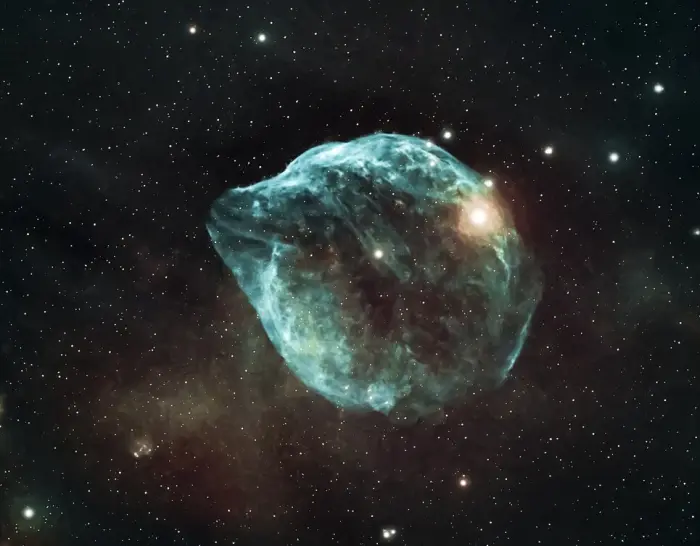
Dolphin Head Nebula (Sh2-308), image credit: Wikimedia Commons/Lucky Budd (CC BY-SA 4.0)
NGC 2283
NGC 2283 is a barred spiral galaxy located 47.8 million light-years away. It has an apparent magnitude of 11.5 and an apparent size of 3.6 by 2.7 arcminutes. It was discovered by William Herschel on February 6, 1785.
The galaxy has an estimated size of 56,500 light-years. It hosted a supernova observed in 2023. Designated SN 2023 axu, the supernova was classified as type II and shone at magnitude 15.6.
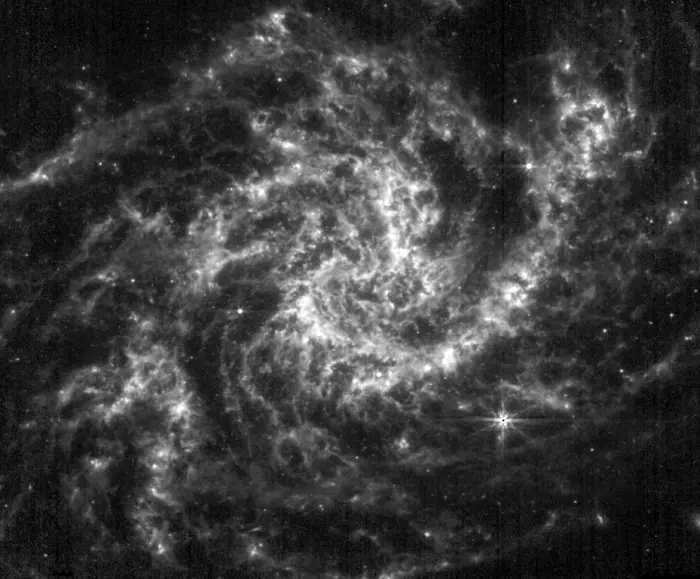
NGC 2283 by the James Webb Space Telescope (JWST), credit: NASA/ESA/CSA JWST MIRI; Adam Leroy et al. (CC BY-SA 4.0)
NGC 2217
NGC 2217 is a barred spiral galaxy located approximately 73 million light-years away. It has an apparent magnitude of 11.71 and an apparent size of 4.44 by 4.84 arcminutes. It was discovered by the English astronomer John Herschel on January 20, 1835.
The galaxy is 100 light-years across. It is the most prominent member of the NGC 2217 Group.
NGC 2217 hosted a supernova detected in 2017. The supernova, SN 2017zw, was classified as type I and reached a magnitude of 17.1.
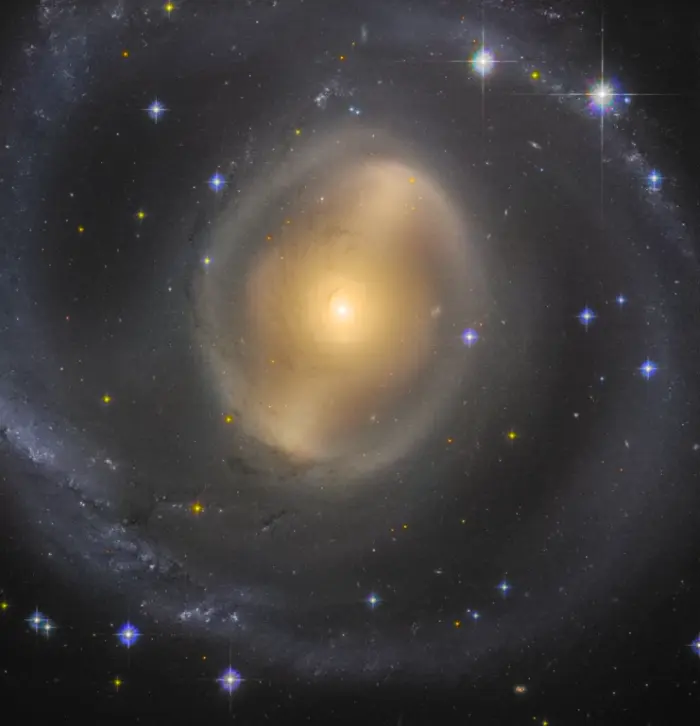
A magnificent barred spiral galaxy with arms tightly wound into near continuous circles. This was colorized using PanSTARRS z/i/g survey data. Image credit: Judy Schmidt (CC BY 2.0)
NGC 2280
NGC 2280 is a spiral galaxy located around 74.6 light-years away. It has an apparent magnitude of 10.5 and an apparent size of 6.3 by 3.1 arcminutes.
The galaxy is around 135,000 light-years across. It harbours a central supermassive black hole with a mass between 4 and 15 million solar masses. It is the most prominent member of the NGC 2280 Group of galaxies, which also includes NGC 2293 and several other galaxies.
In 2001, a type II supernova, SN 2001fz, was observed in the galaxy. It peaked at magnitude 17.4.
NGC 2280 was discovered by John Herschel on February 1, 1835.
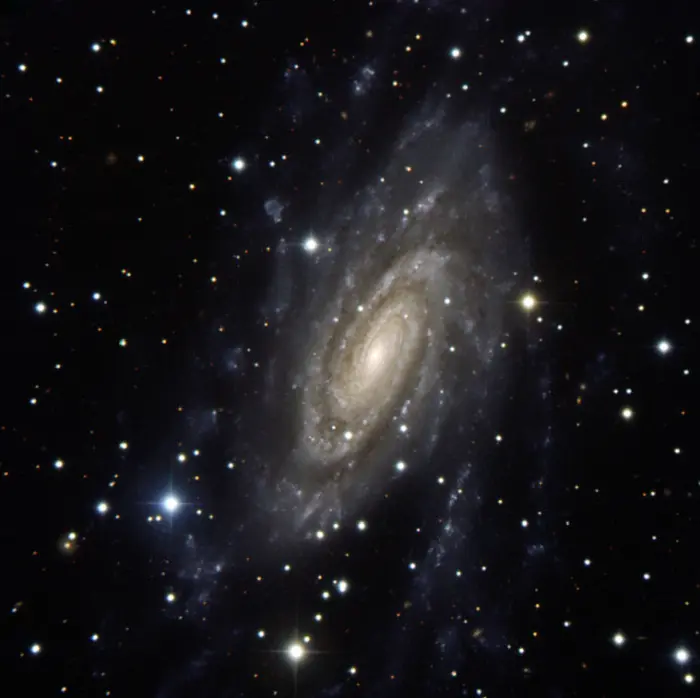
This image of the galaxy NGC 2280 shows the extent of its massive spiral arms that reach far into the surrounding space. These star-filled tentacles taper off into wispy blue clouds of illuminated and glowing gas well away from the central, bright bulge of the galaxy. Found towards the constellation of Canis Major (the Greater Dog), NGC 2280 is thought to be similar in shape to our own Milky Way galaxy. NGC 2280 whirls in the cosmos about 75 million light years from us; this snapshot therefore shows the galaxy as it appeared when dinosaurs still roamed the Earth. The very bright stars that sparkle like diamonds in the image, as well as the many other stars of various colors, are all in the foreground of our view, as they lie much closer to us than NGC 2280. The image was captured with the ESO Faint Object Spectrograph and Camera (EFOSC2) through three filters (B, V, R). EFOSC2 was attached to the 3.6-metre telescope at ESO’s La Silla Observatory in Chile. Image credit: ESO (CC BY 4.0)
NGC 2293
NGC 2293 is a lenticular galaxy located approximately 107 million light-years away. It has an apparent magnitude of 11.2 and an apparent size of 4.2 by 3.3 arcminutes, corresponding to a physical diameter of about 160,000 light-years. The galaxy shows hints of a spiral structure.
NGC 2293 is interacting with the nearby galaxy NGC 2292. The two galaxies are surrounded by a ring of neutral hydrogen (HI).
NGC 2293 and NGC 2292 were discovered by John Herschel on January 20, 1835. The galaxies are separated by only 0.8 arcminutes in the sky. Both are members of the galaxy group LGG 138, along with NGC 2280, NGC 2295, and several fainter galaxies.
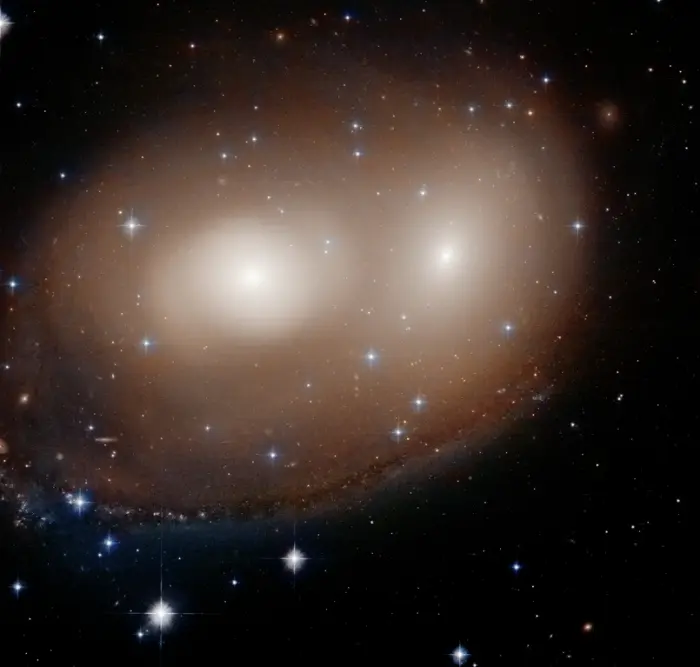
This is a Hubble Space Telescope snapshot of the early stages of a collision between two galaxies that resembles a Halloween carved pumpkin. The “pumpkin’s” glowing “eyes” are the bright, star-filled cores of each galaxy that contain supermassive black holes. An arm of newly forming stars give the imaginary pumpkin a wry smirk. The two galaxies, cataloged as NGC 2292 and NGC 2293, are located about 120 million light-years away in the constellation Canis Major. These images are a composite of separate exposures acquired by the ACS/WFC instrument on the Hubble Space Telescope along with ground-based observations from the Pan-STARRS program. Image credit: NASA, ESA, and W. Keel (University of Alabama) (CC BY 4.0)
Gaia 1
Gaia 1 is an open cluster located 15,000 light-years away. It has an apparent size of 13 arcminutes. It was only discovered in 2017 using data obtained by the Gaia Space Observatory. The Gaia data helped astronomers identify around 1,200 cluster members.
Even though the cluster is both bright and massive, it was previously undetected because it appears 10 arcminutes east of Sirius. The brightest star in Earth’s sky overwhelms the veiling glare in telescopes and has kept the cluster hidden from observers.
Gaia 1 has a half-light radius of 29 light-years and a mass of around 22,000 Suns. It is believed to be 6.3 billion years old.
Collinder 140
Collinder 140 is a bright open cluster located approximately 1,226 light years away. It has an apparent visual magnitude of 3.5 and an apparent size of 60 arcminutes. The cluster was discovered by the French astronomer Nicolas Louis de Lacaille, who catalogued it in 1751. Swedish astronomer Per Collinder listed it in his catalogue in 1931.
Collinder 140 has an estimated age of only around 20 million years. Astronomers suspect that it formed in the same stellar nursery as the open clusters NGC 2516 (the Southern Beehive, Caldwell 96) in the constellation Carina and NGC 2457 in Vela.
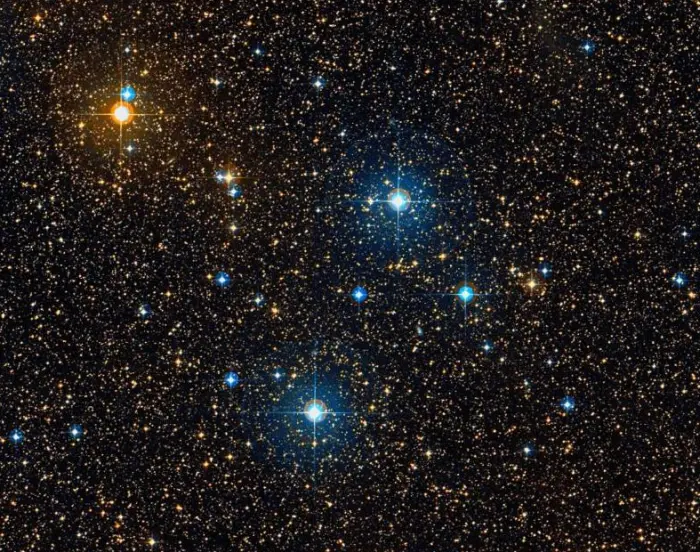
Collinder 140, image: Wikisky (DSS2)